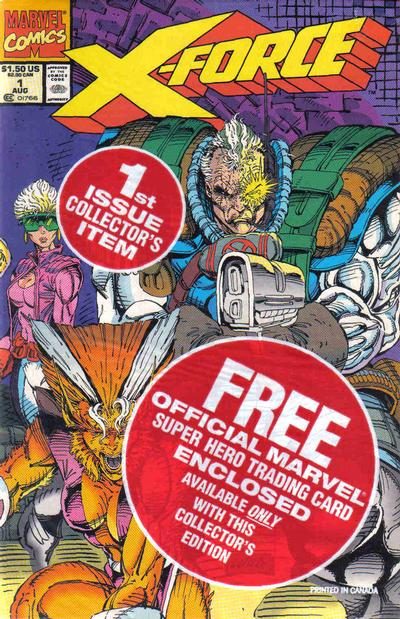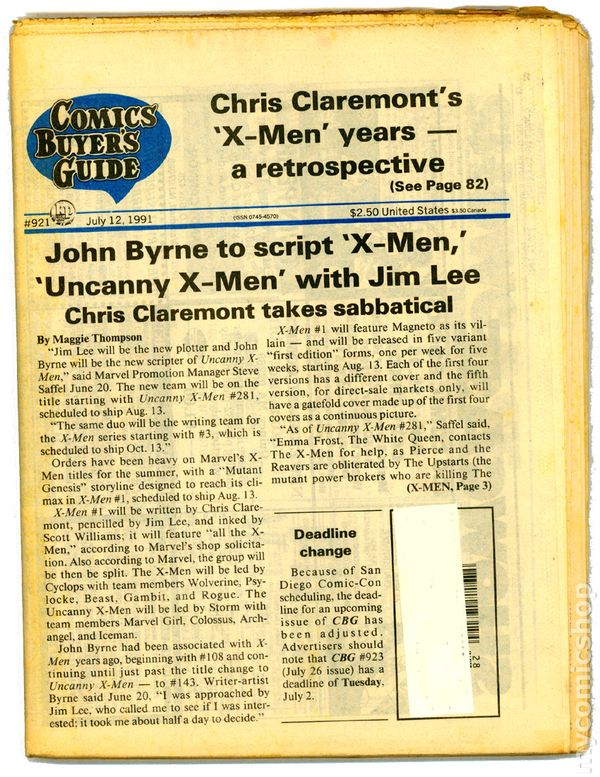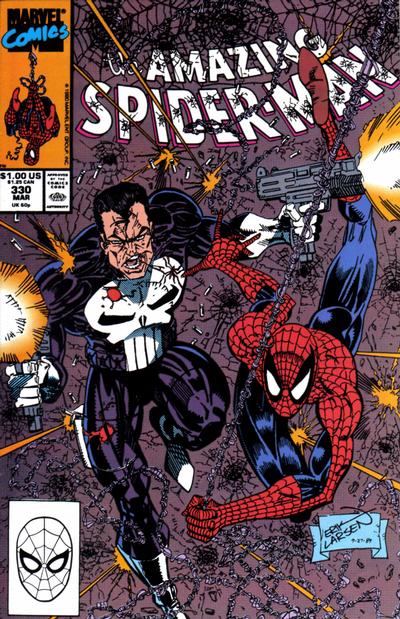The summer of 1991 was huge for two reasons: X-Force #1 (Aug. 1991) and X-Men #1 (Oct. 1991).
I was mostly buying new comics from AAA Best, where I had a pull list. But I was really into it at this point and spent most of my free time that summer hitting every comic shop I could find in the Phoenix area. All About Books and Comics was my No. 2 choice. They had their main store on Camelback Road and also a small Scottsdale location close to where I was staying with my parents.
Most of the comics I was reading at this point were solidly entertaining, and I was buying a lot of them, so I wasn’t trying a ton of new books. Batman, Spider-Man, Justice League, Doom Patrol, Avengers, The Sandman, Hellblazer and probably a few others were keeping me pretty busy.
It was all about the X-Men that summer. The commercial success of the book with Jim Lee on it just spilled over into everything. Interest in X-Men comic books may never have been higher. Both the collector crowd, dominated at this time by speculators who bought up multiple copies — even cases! — of new issues as they came out, and the fans more into the creative and storytelling side of things were unable to resist the oncoming onslaught of X-Men books.
But this interest also was so intense, it couldn’t help but radically change the comics themselves. When Chris Claremont took over as writer on X-Men in 1974, this was a very small and unimportant corner of the Marvel Universe. A mere 17 years later, X-Men and its various spinoffs were an industry of their own. The demand for X-Men material was insatiable, and Marvel was more than happy to do its best to deliver.
There was one problem. Claremont and his closest collaborators — the artists he worked with, as well as the editors who backed him, most notably Louise Simonson and Ann Nocenti — couldn’t deliver on their own nearly enough material to meet that demand, though they appeared to have a solid grip on the core of the X-Men franchise. And other comics creators, spying the very large checks X-Men books generated under Marvel’s sales incentives program, wanted a piece of that pie.





That changed with the publication of Barry Windsor-Smith’s Weapon X serial in Marvel Comics Presents #72-84 (March-September 1991). Claremont for years resisted any attempt to fill in the gaps in Wolverine’s past, and now another creator was doing exactly that.

Cover art by Barry Windsor-Smith.
Suddenly, copies of Marvel Comics Presents were hard to find. I had missed a number of issues prior to Weapon X and had to track down the first issue in particular by visiting just about every store in the Phoenix area before finding one at, I believe, All About Books and Comics.
As the release of X-Force #1 approached, there was a lot of excitement because, for the first time I could remember, comics were becoming popular within the larger culture. I saw people wearing X-Force T-shirts at Target. The Levi’s TV ad featuring Rob Liefeld and Spike Lee was a minor sensation on TV. Comics shops on new release day and weekends were crowded.
And suddenly the comics world didn’t seem so distant from the rest of the world.
I stopped by AAA Best the day that X-Force #1 came out — the first week of June 1991 — to pick up my regular stack of comics as well as take part in that momentous event. The store was more crowded than I’d ever seen it, with people lining up to buy huge stacks of copies of that issue. One guy proudly boasted that he was buying 25 copies of the book – and that this was nothing compared to what he was going to get when X-Men #1 came out.

Cover art by Rob Liefeld.
While there was only one cover, each copy of X-Force #1 was polybagged with one of five trading cards drawn by Liefeld. That means most people bought six copies — five to save, and one to open and read. Within a week, I saw All About’s main location was selling the extra cards from opened copies — for a premium. There also was a brief sensation about a certain number of copies that for some reason had a reversed image of Captain America in the UPC box on direct market issues. I don’t know if that’s a legit variant, but I did scoop up an extra set of those for some reason I’m glad to have forgotten.

I spent most of my free time that summer driving through the desert heat from comic shop to music store to movie theater to bookstore and back around again. One of the nearby stops was a Bookstar outlet in the then-still-new Scottsdale Pavilions. They didn’t have much in the way of comics, but they did have a big newsstand that included copies of the Comics Buyers’ Guide. I doubt I’ll ever forget picking up the July 12 issue and reading that Jim Lee was taking over as plotter of the book, with John Byrne stepping in to script, while Claremont took a “sabbatical.” This was less than a month before X-Men #1 was due out.

There was no internet back then, and few publications that carried comic book news in a timely enough fashion to learn any more details before X-Men #1 came out on Aug. 13, 1991. The new issues of The Uncanny X-Men offered no hint of what was to come. Jim Lee stopped drawing the series after issue #277 (June 1991), with the incredible Paul Smith returning for #278 (July 1991), and Andy Kubert on #279 (Aug. 1991), on which Claremont’s run ended halfway through the comic. The rest was by Fabian Nicieza, who wrapped up the storyline in #280 (Sept. 1991) and set the stage for the Mutant Genesis relaunch.



That summer also was a big one for Star Trek, which was celebrating its 25th anniversary. Star Trek: The Next Generation continued to thrive on TV, its reputation growing with every new episode that aired. The original crew also was due back for one final voyage, with Star Trek VI: The Undiscovered Country scheduled for a December release. Not only was the original crew getting back together, but Star Trek II: The Wrath of Khan director and writer Nicholas Meyer was returning to both roles. There also was a rumor that TNG’s Michael Dorn had been cast in a small role in the movie.
The teaser trailer was frustratingly unspecific, but the title — originally meant by Meyer for Star Trek II — was terrific and built up expectations for a satisfying and very final finale.

Cover art by Jerome K. Moore.

Cover art by Jerome K. Moore.
On the comics side, DC put two more great Star Trek annuals, and put together the first sanctioned crossover between TOS and TNG with a pair of four-issue miniseries called The Modala Imperative. The creative teams swapped, with TNG comic scribe Michael Jan Friedman starting things off with a four-issue story of Kirk and Co. that was released biweekly that summer.




It was followed up with a sequel TNG series by regular TOS scribe Peter David that brought back Admiral McCoy from the TNG premiere episode “Encounter at Farpoint,” as well as an older Spock who was now an ambassador. (That last detail later panned out on the show itself when Leonard Nimoy returned that fall for a two-episode run as Spock on TNG, “Reunification.”)




Cover art by Adam Hughes.
There also was to be an original hardcover TOS graphic novel titled Debt of Honor from Chris Claremont and artist Adam Hughes, but it was delayed into 1992. More on that later.

Cover art by Jim Lee and Scott Williams.

Cover art by Jim Lee and Scott Williams.

Cover art by Jim Lee and Scott Williams.

Cover art by Jim Lee and Scott Williams.
August was the big month. With X-Men #1 (Oct. 1991), Marvel was releasing five variants of the double-size first issue. The first four would be standard format comics with covers that would connect to form a single image. Each also had its own pinup spread by Jim Lee. The fifth edition was a deluxe edition on glossy paper with no ads, all the spreads from the other four variants, a double gatefold cover with all four of the other covers as a single image, and some bonus sketches by Lee. The editions were released once a week, rather than all at once, with Marvel pushing back the release of X-Men #2 (Nov. 1991) a week to make room for the deluxe edition room to have its own week in the spotlight.

Ken Strack at AAA told me that he thought the deluxe edition might be hot enough to be worth something. But at that time no one expected Marvel would print and ship 8 million copies of the book, making it the highest-selling comic of all time (at least to comics shops) and the most common. I picked up a couple copies of the first edition at AAA Best on the day of release, also swinging by All About’s Scottsdale location just to get some of the contact buzz.
Reading the book was bittersweet. It was much better than X-Force #1, featuring the full-on return of Magneto as a villain, some cool Danger Room shenanigans to introduce the new Lee costume designs, an orbital nuclear blast, and a final showdown in Genosha. To be continued!

Cover art by Whilce Portacio and Art Thibert.
The Uncanny X-Men #281 (Oct. 1991), came out the same day as the first edition of X-Men #1, and was more of a mess. Marvel countered Claremont’s departure by bringing back John Byrne to script both series over plots from Jim Lee (starting in X-Men #4 (Jan. 1992)) and Whilce Portacio in Uncanny #281. While Portacio’s art was exciting, let’s just say letting an artist with limited writing ability plot one of your most visible and top-selling series is about as good an idea as it sounds. The story involved some Sentinels, the return of the Hellfire Club, and some new villains that didn’t make much of an impression at the time.

Cover art by Jim Lee and Scott Williams.
Claremont changes his plans for the series to wrap things up as best he could. While X-Men #1 was originally intended to be an introductory issue Claremont referred to as “X-Men 101,” it now kicked off a three-issue storyline that attempted to resolve the Xavier-Magneto conflict in some kind of convincing manner. When X-Men #3 (Dec. 1991) shipped in October, it was truly the end of an era. There was no acknowledgement of Claremont’s departure, no farewell message — no mention in any way that the man arguably most responsible for this commercial triumph was being displaced from that role.

Cover art by Jim Lee and Scott Williams.
Between the release of the first edition of X-Men #1 and the fifth edition, I returned to Tucson and the University of Arizona for my final semester. I was originally slated to be the assistant news editor for the Arizona Daily Wildcat, but after only a few weeks found myself promoted to full news editor, in charge of keeping something like eight reporters busy covering the goings on of a campus of 36,000 students. Oh, and a full load of classes, too.
Next: How I almost — almost! — stopped buying comics after graduation.












































